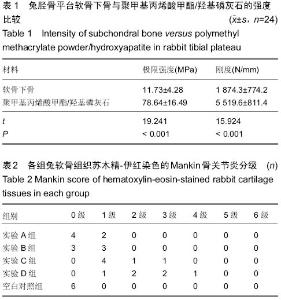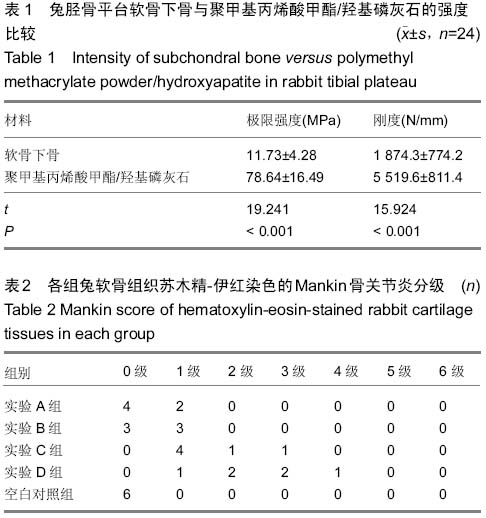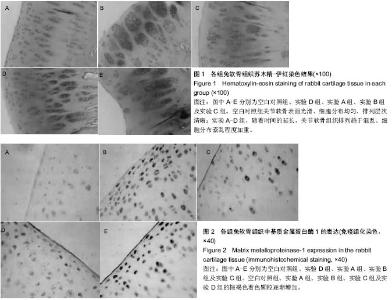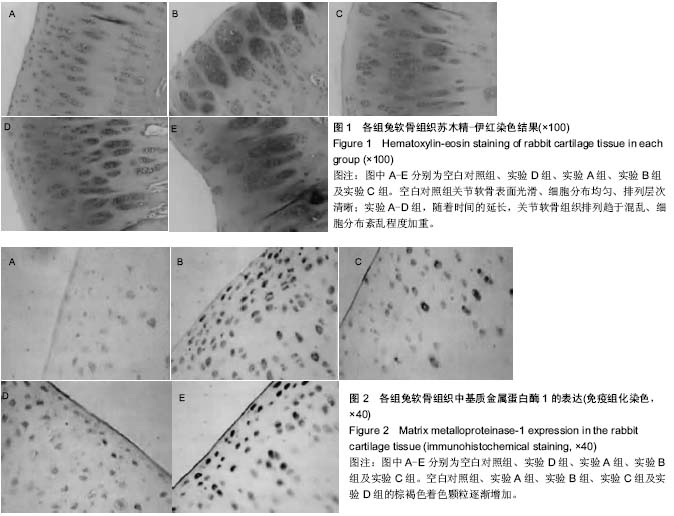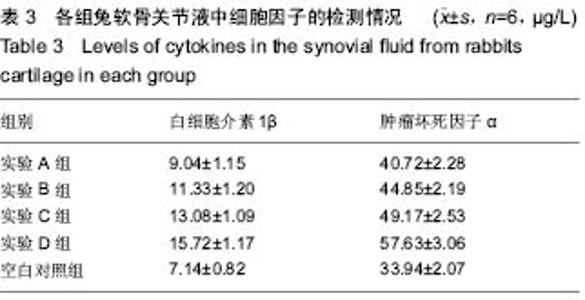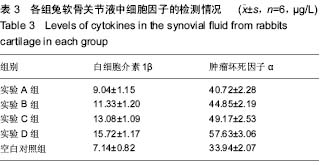Chinese Journal of Tissue Engineering Research ›› 2015, Vol. 19 ›› Issue (25): 3962-3966.doi: 10.3969/j.issn.2095-4344.2015.25.006
Previous Articles Next Articles
Acrylic resin bone cement composite as a bone substitute for subchondral bone induces knee joint osteoarthritis
Jiang Hua1, Yan Yu2, Ma Hong-bing1, Xu Bing1, Wang Jun-rui1, Jiang Dian-ming3
- 1Department of Orthopedics, Chengdu Second People’s Hospital, Chengdu 610016, Sichuan Province, China;
2Department of Orthopedics, West China Hospital, Sichuan University, Chengdu 610016, Sichuan Province, China;
3the First Affiliated Hospital of Chongqing Medical University, Chongqing 400042, China
-
Online:2015-06-18Published:2015-06-18 -
Contact:Yan Yu, Department of Orthopedics, West China Hospital, Sichuan University, Chengdu 610016, Sichuan Province, China -
About author:Jiang Hua, Master, Attending physician, Department of Orthopedics, Chengdu Second People’s Hospital, Chengdu 610016, Sichuan Province, China
CLC Number:
Cite this article
Jiang Hua, Yan Yu, Ma Hong-bing, Xu Bing, Wang Jun-rui, Jiang Dian-ming. Acrylic resin bone cement composite as a bone substitute for subchondral bone induces knee joint osteoarthritis [J]. Chinese Journal of Tissue Engineering Research, 2015, 19(25): 3962-3966.
share this article
| [1] 曾花,蔡道章,陈郁鲜,等.人膝骨关节炎血清生物学标志物的筛选[J].中国病理生理杂志,2012,28(5):884-888.
[2] 向珍蛹,茅建春,曲环汝,等.浦东上钢社区中老年人群膝骨关节炎危险因素的流行病学研究[J].上海交通大学学报:医学版,2013, 33(3):318-322.
[3] 乐意,金荣疆,阳杨,等.从下肢生物力学来解析膝骨关节炎[J].中国康复理论与实践,2013,19(6):505-509.
[4] Fransen M,McConnell S.Land-based exercise for osteoarthritis of the knee:a meta-analysis of randomized controlled trials.J Rheumatol.2009;36(6):1109-1117.
[5] 朱芳晓,周润华,石宇红,等.小白菊内酯对兔膝骨关节炎血清IL-1β及TNF-α的影响[J].中国中西医结合杂志,2013,33(10): 1382-1384.
[6] 刘洪柏,张鸣生,区丽明,等.体外冲击波对大鼠膝骨关节炎白细胞介素-1β及肿瘤坏死因子-α表达的影响[J].中国康复医学杂志, 2014,29(3):208-211.
[7] 李强,周国庆,邓紫婷,等.复元胶囊对膝骨关节炎大鼠IL-1β、OPG和OPGL mRNA表达的影响[J].中国老年学杂志,2014,34(14): 3930-3933.
[8] 张冲,季亚成,张英泽,等.传统中医药补肾固筋方对膝骨关节炎中IL-1、TNF-α表达的影响[J].中国骨质疏松杂志,2013,19(6): 568-571.
[9] 高润成,王志文,袁强,等.麝香乌龙丸对兔膝骨关节炎软骨组织形态及p38MAPK,Caspase-3表达的影响[J].中国实验方剂学杂志, 2013,19(11):228-231.
[10] 王桂芳,李晓君,杨栋慧,等.蚁龙通痹汤对兔膝骨关节炎软骨细胞凋亡调控基因表达的影响[J].中国实验方剂学杂志,2013,19(13): 246-250.
[11] 王兴桂,王政,郑曙光,等.苗药组方熏洗对家兔早期膝骨关节炎模型软骨细胞Bax、Bcl-2影响的实验研究[J].中华中医药杂志, 2014,29(2):632-635.
[12] 黄永明,潘建科,郭达,等.Ⅱ型胶原蛋白酶诱导SD大鼠膝骨关节炎模型的建立[J].广东医学,2015,36(8):1.
[13] 刘洪柏,侯晓东,张鸣生,等.低能量体外冲击波对实验性膝骨关节炎兔膝关节软骨的影响[J].广东医学,2013,34(22):3382-3385.
[14] 江晓兵,黄伟权,庞智晖,等.基于Mimics软件计算椎体强化术后椎体内骨水泥体积及骨水泥/椎体体积比的新方法[J].中国脊柱脊髓杂志,2013,23(3):238-243.
[15] 岳文峰,夏虹,王建华.骨水泥强化椎弓根螺钉固定对骨质疏松患者有利无弊?[J].中国组织工程研究,2013,17(17):3081-3088.
[16] 陈跃平,陈亮,高辉,等.骨水泥与非骨水泥型全膝关节假体置换效果的系统评价[J].中国组织工程研究,2013,17(17):3132-3139.
[17] 韩卫东,黄爱军,陈丽萍.注入骨水泥治疗胸腰椎骨质疏松性骨折:成熟技术中的常见问题[J].中国组织工程研究,2013,17(26): 4912-4918.
[18] 王诗军,邑晓东,李淳德,等. 经皮椎体成形中椎旁血管渗漏与骨水泥性肺栓塞[J].中国组织工程研究,2013,17(47):8275-8281.
[19] 胡妍文,王晓文,唐正海,等.微米级羰基铁粉磁性骨水泥的制备与表征[J].中国组织工程研究,2013,17(47):8155-8161.
[20] 王鹏,皮斌,王金宁,等.壳聚糖微球复合丝素基硫酸钙骨水泥的理化特性[J].中国组织工程研究,2014,18(12):1831-1838.
[21] 郭立燕,张雪文,翟敏,等.骨关节炎影响因素的1:1配对病例对照研究[J].中华疾病控制杂志,2012,16(8):651-653.
[22] 马春辉,阎作勤,郭常安,等.Ⅱ型胶原与Bcl-2在骨关节炎软骨细胞中的表达[J].中国矫形外科杂志,2012,20(19):1786-1789.
[23] 宋华伟,蒋毅,王东.骨水泥双动头治疗透析患者股骨颈骨折[J].现代仪器与医疗,2014,20(4):57-59.
[24] Veidal SS,Karsdal MA,Vassiliadis E,et al.MMP mediated degradation of type VI collagen is highly associated with liver fibrosis-identification and validation of a novel biochemical marker assay.PLoS One.2011;6(9):e24753.
[25] 江晓兵,黄伟权,庞智晖,等.基于Mimics软件计算椎体强化术后椎体内骨水泥体积及骨水泥/椎体体积比的新方法[J].中国脊柱脊髓杂志,2013,23(3):238-243.
[26] 秦毅,秦杰,江建明,等. PMMA骨水泥与BCC骨水泥对猪肺栓塞后血流动力学的不同影响[J]. 中国矫形外科杂志,2013,21(12): 1223-1227.
[27] 刘瑶瑶,代飞,孙东,等.不同量骨水泥强化新型空心椎弓根螺钉的体外生物力学研究[J]. 第三军医大学学报,2012,34(16): 1626-1629.
[28] 李卫平,蹇睿,胥方元.超声波治疗兔膝骨关节炎对MMP-1和MMP-13表达的影响[J]. 重庆医学,2012,41(16):1564-1566.
[29] 韦桂勇,黄剑,郑玲玲,等.筋骨痹痛丸对家兔膝骨关节炎模型软骨细胞凋亡及mmp-1表达的影响[J].时珍国医国药,2014,25(10): 2376-2378.
[30] 邓紫婷,周国庆,李荣亨,等.复元胶囊对晚期膝骨关节炎大鼠软骨中Ⅱ型胶原及基质金属蛋白酶1和3的影响[J].中国新药与临床杂志,2014,33(10):734-740. |
| [1] | Chen Ziyang, Pu Rui, Deng Shuang, Yuan Lingyan. Regulatory effect of exosomes on exercise-mediated insulin resistance diseases [J]. Chinese Journal of Tissue Engineering Research, 2021, 25(25): 4089-4094. |
| [2] | Chen Yang, Huang Denggao, Gao Yuanhui, Wang Shunlan, Cao Hui, Zheng Linlin, He Haowei, Luo Siqin, Xiao Jingchuan, Zhang Yingai, Zhang Shufang. Low-intensity pulsed ultrasound promotes the proliferation and adhesion of human adipose-derived mesenchymal stem cells [J]. Chinese Journal of Tissue Engineering Research, 2021, 25(25): 3949-3955. |
| [3] | Yang Junhui, Luo Jinli, Yuan Xiaoping. Effects of human growth hormone on proliferation and osteogenic differentiation of human periodontal ligament stem cells [J]. Chinese Journal of Tissue Engineering Research, 2021, 25(25): 3956-3961. |
| [4] | Sun Jianwei, Yang Xinming, Zhang Ying. Effect of montelukast combined with bone marrow mesenchymal stem cell transplantation on spinal cord injury in rat models [J]. Chinese Journal of Tissue Engineering Research, 2021, 25(25): 3962-3969. |
| [5] | Gao Shan, Huang Dongjing, Hong Haiman, Jia Jingqiao, Meng Fei. Comparison on the curative effect of human placenta-derived mesenchymal stem cells and induced islet-like cells in gestational diabetes mellitus rats [J]. Chinese Journal of Tissue Engineering Research, 2021, 25(25): 3981-3987. |
| [6] | Hao Xiaona, Zhang Yingjie, Li Yuyun, Xu Tao. Bone marrow mesenchymal stem cells overexpressing prolyl oligopeptidase on the repair of liver fibrosis in rat models [J]. Chinese Journal of Tissue Engineering Research, 2021, 25(25): 3988-3993. |
| [7] | Liu Jianyou, Jia Zhongwei, Niu Jiawei, Cao Xinjie, Zhang Dong, Wei Jie. A new method for measuring the anteversion angle of the femoral neck by constructing the three-dimensional digital model of the femur [J]. Chinese Journal of Tissue Engineering Research, 2021, 25(24): 3779-3783. |
| [8] | Meng Lingjie, Qian Hui, Sheng Xiaolei, Lu Jianfeng, Huang Jianping, Qi Liangang, Liu Zongbao. Application of three-dimensional printing technology combined with bone cement in minimally invasive treatment of the collapsed Sanders III type of calcaneal fractures [J]. Chinese Journal of Tissue Engineering Research, 2021, 25(24): 3784-3789. |
| [9] | Qian Xuankun, Huang Hefei, Wu Chengcong, Liu Keting, Ou Hua, Zhang Jinpeng, Ren Jing, Wan Jianshan. Computer-assisted navigation combined with minimally invasive transforaminal lumbar interbody fusion for lumbar spondylolisthesis [J]. Chinese Journal of Tissue Engineering Research, 2021, 25(24): 3790-3795. |
| [10] | Hu Jing, Xiang Yang, Ye Chuan, Han Ziji. Three-dimensional printing assisted screw placement and freehand pedicle screw fixation in the treatment of thoracolumbar fractures: 1-year follow-up [J]. Chinese Journal of Tissue Engineering Research, 2021, 25(24): 3804-3809. |
| [11] | Shu Qihang, Liao Yijia, Xue Jingbo, Yan Yiguo, Wang Cheng. Three-dimensional finite element analysis of a new three-dimensional printed porous fusion cage for cervical vertebra [J]. Chinese Journal of Tissue Engineering Research, 2021, 25(24): 3810-3815. |
| [12] | Wang Yihan, Li Yang, Zhang Ling, Zhang Rui, Xu Ruida, Han Xiaofeng, Cheng Guangqi, Wang Weil. Application of three-dimensional visualization technology for digital orthopedics in the reduction and fixation of intertrochanteric fracture [J]. Chinese Journal of Tissue Engineering Research, 2021, 25(24): 3816-3820. |
| [13] | Sun Maji, Wang Qiuan, Zhang Xingchen, Guo Chong, Yuan Feng, Guo Kaijin. Development and biomechanical analysis of a new anterior cervical pedicle screw fixation system [J]. Chinese Journal of Tissue Engineering Research, 2021, 25(24): 3821-3825. |
| [14] | Lin Wang, Wang Yingying, Guo Weizhong, Yuan Cuihua, Xu Shenggui, Zhang Shenshen, Lin Chengshou. Adopting expanded lateral approach to enhance the mechanical stability and knee function for treating posterolateral column fracture of tibial plateau [J]. Chinese Journal of Tissue Engineering Research, 2021, 25(24): 3826-3827. |
| [15] | Zhu Yun, Chen Yu, Qiu Hao, Liu Dun, Jin Guorong, Chen Shimou, Weng Zheng. Finite element analysis for treatment of osteoporotic femoral fracture with far cortical locking screw [J]. Chinese Journal of Tissue Engineering Research, 2021, 25(24): 3832-3837. |
| Viewed | ||||||
|
Full text |
|
|||||
|
Abstract |
|
|||||
